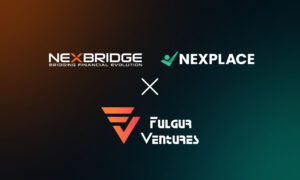Fintech refers to the integration of digital technology and financial services. It has democratized processes and functions previously exclusive to banks and other large institutions. Fintech startups have significantly transformed the global economic landscape, creating seismic shifts in online and offline transactions.
The relentless innovation of fintech companies has been shaking up the status quo and given rise to new implementations of money, payments, saving, banking, trading, investing, and more. The COVID-19 pandemic accelerated the transformation, expanding fintech startups’ influence and reach. It has also generated greater financial inclusion among those without access to banking and other formal services.
In 2024, the momentum is expected to continue. Fintechs will persist on their rapid growth trajectory, expected to grow to $190 billion this year and accelerate to $556 billion by 2030 with a CAGR of 19.5%.
Startup founders will continue aggressively bringing new ideas to market, using software to deliver novel financial services at lightning speed and to more people than ever. Here, we explore the critical directions in the space as we watch emerging companies compete and challenge traditional models, giving way to new paradigms that reshape our financial future.
Top Fintech Startup Trends Founders Should Look Out For
Every year opens up opportunities to reshape the global financial landscape, and startup founders must be keen to take advantage. All fintech founders aspire to become the next fintech giant. The most successful fintechs in the world are multi-billion dollar operations, the top three being Ant Group at a $78.5 billion valuation, Stripe at $50 billion, and Revolut at $33 billion.
Knowledge of the most promising directions is crucial for aspiring or current startup founders. The following are the frontrunner trends influencing the race to develop the next multi-billion dollar fintech company:
Generative AI applications in fintech
Generative AI is among the most hyped buzzwords in business and tech, and fintech has yet to escape its reach. It can be used in various fintech solutions and perform asset management, algorithmic trading, credit scoring, and fraud prevention tasks.
Financial service companies will find that the expanding capabilities of generative AI will continue to influence the development and delivery of their services. They will be able to apply it to even more scenarios.
AI-enabled algorithmic trading, for example, allows the analysis of real-time market conditions and market data at unprecedented timing and speed, allowing better-informed decisions with minimal human involvement. Algorithmic trading paves the way for pre-programmed trading directives, automating the entire process and accommodating time, price, and volume.
Other promising applications are risk assessment and credit scoring, wherein generative AI assesses spending patterns, transaction records, historical trends, and other relevant client data. Incorporating generative AI allows for increased accuracy in decision-making without human bias. A clear example is when a client’s trustworthiness or the reliability of an investment needs review.
Intelligent automation (IA)
Intelligent automation involves merging three cognitive technologies: artificial intelligence or AI, business process management (BPM), and robotic process automation (RPA).
It enhances company productivity by transforming core finance processes and increasing their speed, cost-efficiency, and accuracy. Companies must create finance-specific utilities different from those deployed within other business functions.
Deloitte expects intelligent automation, combined with improvements in management and the inclusion of robotics, to yield an additional 20 to 25 percent in productivity.
Embedded finance
Embedded finance, or embedded financial solutions, integrates financial services into non-financial platforms. This application is expected to skyrocket in 2024 as e-commerce sites increasingly merge into ordinary payment experiences in every imaginable site.
The embedded fintech service can offer any financial functionality like payments, insurance, or loans and integrate it into different businesses. One lucrative application would be adding payments to social media sites with massive user bases. Another example would be allowing customers to utilize digital wallets or new fintech payment methods, such as an online savings account, to facilitate an online purchase.
The trend for embedded finance started when the financial services industry realized that there was a massive opportunity to offer services direct-to-consumer without the help of banks. In turn, banks had to embrace embedded finance solutions. This pivot led to the creation of digital-only banks.
Embedded finance is among the most profitable trends to arise from fintech. It promises to unlock an immense opportunity—more significant than the combined value of top global banks, insurers, and all fintech startups. According to Fintech Switzerland, the sub-sector will reach $7.2 trillion by 2030. Some disagree with this figure. A Forbes magazine article stated that while the opportunity is massive, the $7.2 trillion figure is inaccurate.
Nonetheless, startup founders can capitalize on the trend by building new fintechs around this idea or building more integrations that expand the reach of their current fintechs.
Web developers like Brain Box Labs play a crucial role in realizing the full potential of embedded finance in startups. They are instrumental in converting companies to embedded finance platforms, possessing the skills to integrate new financial functionalities into existing platforms seamlessly or, when necessary, build new ones from scratch.
Founders must work closely with developers to sync the design of the user experience (UX) and user interface (UI) with the overall product experience. The core team must identify the areas where new financial features can add value to execute an embedded finance model.
Buy now, pay later (BNPL)
Buy now, pay later has become increasingly integrated into consumer behavior. In 2023, consumers purchased a record number of goods using this service. The BNPL concept has transformed shopping by allowing customers to buy goods without paying immediately.
Under BNPL, a type of short-term financing, payments are split into installments. This trend in fintech services has become popular for consumers seeking budget-friendly and more flexible options for their expenses.
The downside of such apps and fintech services is the wave of debt that awaits consumers after high spending, such as the holidays.
The rise of the super app
A super app is a widely encompassing web or mobile application integrating multiple services into a single platform. Super apps are essential because of the growing use of smartphones worldwide—the figure currently at 6.84 billion.
Approximately 1.2 billion use the super app WeChat. According to a 2022 prediction by Gartner, over 50 percent of the global population will be super app users by 2027.
The race to the ultimate super app has long been underway, as giants like Grab, Alipay, and WeChat try to take over diverse services covering fintech and beyond. These super apps were expected to grow in functionality, expand into various sectors, and reach a market of $887.3 billion in 2033.
Elon Musk has similar aspirations for X. The tech CEO is trying to position the company, formerly Twitter, as an “everything app.” It has recently launched a dedicated user payments account, stoking predictions about future crypto integration.
Speculators are betting that X payments could include the famous “meme coin” Dogecoin. A mini-rally of DOGE followed the announcement. However, X could easily be said to integrate conventional payments facilitated by behemoths like Visa and Mastercard or payment giants like Paypal, Stripe, and Square. These facilitators compete to get more of the embedded finance pie or are already heavily involved in integrating into many top business sites.
Blockchain integration
Blockchain is no longer a new thing but a vital technology that could usher in more growth in the fintech world. Blockchain covers many fintech applications, including centralized and decentralized projects. DeFi is on the decentralized end of these applications, while CBDCs (central bank digital currencies) concentrate digital money in the hands of governments.
Blockchain solutions enable cross-border payments, cheaper transactions, new models of lending and borrowing, including P2P or peer-to-peer lending, and better trade finance.
Embrace the Latest Technology To Boost Your Startup’s Success
Fintech culture leverages technology to get ahead of the game versus traditional players and create new opportunities. It gives rise to positive social change that empowers the unbanked and underserved, allowing more people to access services through the convenience of their smartphones.
The fintech world, however, is notoriously cutthroat. Startups are in a bitter battle to the top, deploying vast amounts of capital to deliver novel services they hope will resonate with users.
To survive in this highly competitive game, startup founders must be passionate technologists, just as they are dedicated agents of transformation. Adaptability, familiarity with software, and the mental agility to cope with accelerated change are all crucial when building and capturing market share versus financial incumbents.



































